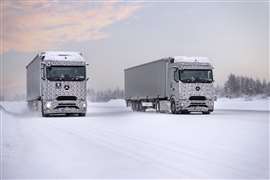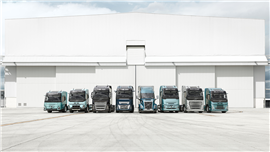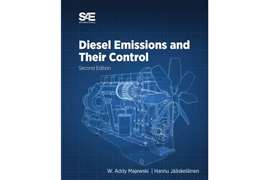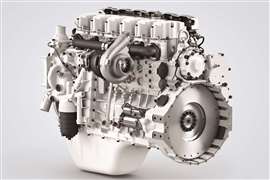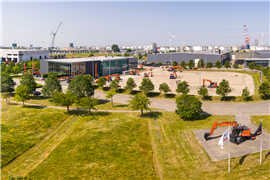Read this article in Français Deutsch Italiano Português Español
How some truck makers are addressing 2025 EU GHG emissions requirements
10 April 2024
Recently on both sides of the Atlantic, regulators have been further addressing greenhouse gas (GHG) emissions from heavy-duty trucks.
In February, Reuters reported that European Union (EU) countries voted to tighten emissions regulations on trucks in the future. The law, which still must be passed by the EU Parliament, would see carbon dioxide (CO2) emissions cut 90 percent by 2040.
Then in March in the U.S., the Environmental Protection Agency (EPA) finalized Phase 3 rules for heavy-duty on-highway vehicle GHG emissions, beginning with the 2027 model year. It’s a move that is causing consternation for some in the trucking industry.
Nonetheless, there are existing GHG regulations with tighter timelines the trucking industry has already been working to address. One such rule is EU Regulation 2019/1242 — the first to set CO2 emissions targets for heavy-duty vehicles across the entire European Union, according to the International Energy Agency (IEA). Beginning with the 2025 model year, CO2 emissions from heavy-duty trucks must be 15 percent less than the 2019/2020 reference year.
With enforcement of the regulation only about a year away — the first reporting period begins July 1, 2025 — Power Progress asked several truck manufacturers about how they plan to comply.
Daimler Truck
A spokesperson for Daimler Truck said its commitment to the Paris Agreement is driving it the company to offer only new carbon-neutral vehicles in its core markets — EU-30, the U.S. and Japan — by 2039.
“At Daimler Truck we set the strategic course with a forward-looking product strategy and respective product decisions years ago,” the company said, “which are now going into series production in time to reach the 2025 targets. This includes not only our battery electric flagship long-haul truck Mercedes-Benz eActros 600, but also the latest generation of fuel-efficient diesel vehicles.”
Daimler Truck said it offers a wide range of battery electric (BE) vehicles. These include the Mercedes-Benz eEconic, the Fuso eCanter, the Mercedes-Benz eActros 300/400 and with production starting by the end of the year, the eActros 600.
Hydrogen fuel cell trucks, by comparison, are appropriate for particularly flexible and demanding heavy-duty transport and long-distance haulage applications, the company said. Daimler Truck said it plans for series production of hydrogen fuel cell trucks within the second half of the decade.
“All in all, our current vehicle portfolio not only puts us in a good position to achieve the 2025 CO2-reduction targets, but we are also well-prepared for the time beyond with our dual-track strategy with both battery electric and hydrogen-powered drive trains,” the company said.
Scania
According to Jacob Tärnå, head of sustainable transport for Scania, the 2025 emissions targets defined by the EU CO2 regulation have been challenging and have required innovations in both internal combustion (IC) engines and BE vehicles.
“The main contribution towards the 15 percent for 2025 comes from efficiency advantages and improvements in the traditional product, leading to reduced fuel consumption,” he said. “This is part of Scania’s DNA, and we continuously improve both through product development and by ensuring that we specify optimal components for each type of transport operation.”
Tärnå said Scania was starting from a position of strength in complying with the forthcoming GHG regulation, as in 2019, the company was the benchmark for fuel efficiency.
“It will also be necessary to ensure that a certain, rather small share of our sales in the 2025 legislative year come from technology with zero local emissions,” he added. “Scania’s focus here is on battery electric trucks that — given enabling conditions such as charging infrastructure — will also show a TCO (total cost of ownership) benefit to many customers depending on operational conditions already in 2025.”
Volvo Trucks
When the EU first introduced CO2 limits for heavy-duty trucks in 2019, Volvo Trucks was already delivering battery electric trucks and gas-driven models throughout Europe, the company said. It added that its fuel-efficient combustion engines helped reduce CO2 emissions.
“We know that our increased sales of Volvo trucks with fuel saving systems, tires with better rolling resistance and better aerodynamics devices all have a very positive impact when reducing CO2,” the company said through a spokesperson.
According to Volvo Trucks, the Volvo FH Aero, which was launched in January, can cut energy consumption and CO2 emissions by up to 5 percent via the truck’s improved aerodynamics and new technologies.
“Regardless of which powertrain truck buyers choose — electric, gas or diesel — all variants of the new Volvo FH Aero will bring lower energy consumption. Consequently, we are confident that we will reach the European Union’s 2025 CO2 regulation targets.”
Concerning proposed revisions to the EU CO2 regulation that have yet to be formally approved, Volvo Trucks said “that ambitious CO2 emission targets for truck manufacturers must be matched by equally ambitious public policy support to establish the necessary enabling conditions in society.” The company added that in terms of public policy, decarbonizing heavy-duty trucking requires “electric charging and hydrogen fuel infrastructure, supporting electric grids, carbon pricing and investment support for transport operators.”
|
POWER SOURCING GUIDE
The trusted reference and buyer’s guide for 83 years
The original “desktop search engine,” guiding nearly 10,000 users in more than 90 countries it is the primary reference for specifications and details on all the components that go into engine systems.
Visit Now
STAY CONNECTED




Receive the information you need when you need it through our world-leading magazines, newsletters and daily briefings.
CONNECT WITH THE TEAM










